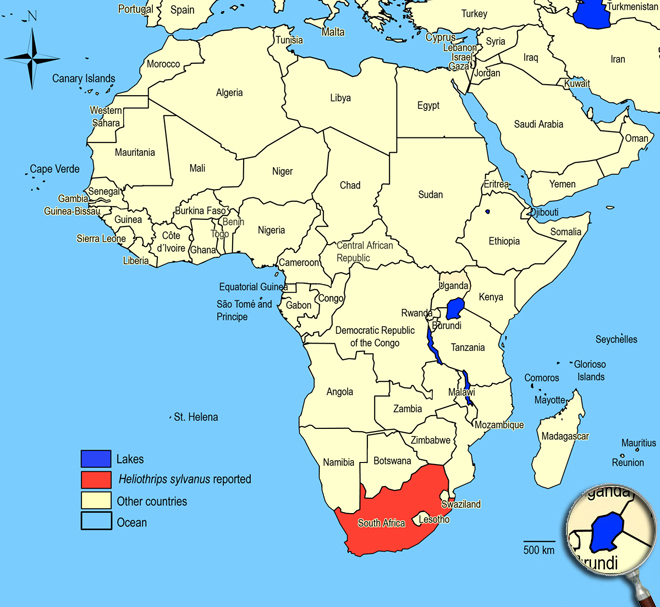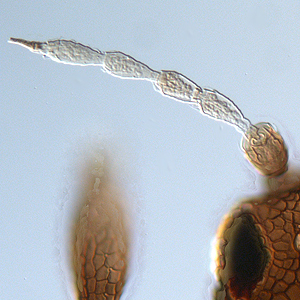Heliothrips sylvanus Faure, 1933
Panchaetothripinae, Thripidae, Terebrantia, Thysanoptera
Figures
Fig. 1: 8-segmented antenna
Fig. 2: Head dorsal with ocellar triangle
Fig. 3: Head and pronotum
Fig. 4: Pro- and mesonotum
Fig. 5: Meso- and metanotum
Fig. 6: Fore wing and fore wing apical region
Fig. 7: Tergites IV-VI
Fig. 8: Tergites VI-VIII
Fig. 9: Sternites IV-VI
Fig. 10: Tergites IX and X
Fig. 11: Tergites VIII-X, male
Introduction and recognition
Heliothrips sylvanus causes damage on leaves of avocado, grapes, guava and persimmon. Both sexes fully winged. Body, legs and antennal segments I & II dark brown; antennal segment III basally, VI apically and VII and VIII brown; III apically, IV and V and VI basally pale; fore wings pale with hind margin shaded. Antennae 8-segmented; segments III and IV with sense cone simple; VIII at least 3 times as long as VII (Fig. 1). Head as long as wide, strongly reticulate, cheeks parallel and constricted at base (Fig. 2). Pronotum reticulate, with no long setae (Fig. 3). Mesonotum with an incomplete median division (Fig. 4). Metanotum with strongly reticulate triangle; median setae small on anterior half of sclerite (Fig. 5). Mid and hind tarsi short and 1-segmented. Fore wing slender with apex rounded bearing 2 long cilia; fore wing first vein close to or fused to costal vein, costa without long cilia, posteromarginal cilia not wavy; veinal setae not much larger than surface microtrichia (Fig. 6). Tergites covered by large hexagonal reticulations except for a pair of posterior submedian smooth areas; tergites II-VIII with 1 pair of small setae medially (Fig. 7); VIII with posteromarginal comb of short microtrichia on broadly triangular bases (Fig. 8); X short but with complete median division (Fig. 10). Sternites with 3 pairs of small marginal setae (Fig. 9).
Male similar to female; tergite IX with 3 pairs of stout thorn-like setae (Fig. 11); sternites III-VII each with a large kidney-shaped transverse glandular area.
Taxonomic identity
Species
Heliothrips sylvanus Faure, 1933
Taxonomic history
Heliothrips pullus Moulton, 1936
Common name
Guava thrips
Present taxonomic position
Family: Thripidae Stephens, 1829
Subfamily: Panchaetothripinae Bagnall, 1912
Genus: Heliothrips Haliday, 1836
Genus description
The genus Heliothrips Haliday, 1836
There are 4 species within this genus, one of each from South Africa, Indonesia and South America, and the greenhouse thrips, Heliothrips haemorrhoidalis, that is now distributed worldwide (Mound & Kibby 1998). All of the species are flattened dorso-ventrally and show heavy reticulation. The head is covered with polygonal reticulations and has a constricted neck, antennae are 8-segmented, antennal segments III & IV have a simple sense cone, fore wings have straight cilia on the posterior margin, minute setae on veins, and a rounded apex and a swollen base (Mound & Marullo 1996; Wilson 1975).
Species description
Typical key character states of Heliothrips sylvanus
Coloration and body sculpture
Body color: mainly brown to dark brown
Surface of head, pronotum and fore legs: with heavy, often polygonally reticulate sculpture
Sculptured reticles on head and pronotum: with no internal markings
Antennae
Form of sense cones on antennal segments III and IV: emergent and simple on segments III and IV
Number of antennal segments: 8
Terminal antennal segments: segments VI-VIII forming a single unit
Head
Cheeks shape: constricted to basal neck
Head occipital ridge dorsally: absent
Head: not prolonged in front of compound eyes (misinterpreted: distinctly prolonged)
Head length to wide: length = width
Ocelli: present
Prothorax
Pronotal blotch or internal apodeme: absent
Pronotum shape: broadly rectangular
Pronotum surface: with mainly equiangular reticulations
Mesothorax
Mesonotum: with an incomplete median division
Metathorax
Metanotum with dominant sculptured triangle medially: with dominant sculptured triangle medially
Shape of metathoracic furca: transverse, V-shaped
Wings
Fore and hind wings: present, more than half as long as abdomen (macropterous)
Fringe cilia arising: from sockets
Fore wing veins: present
Fore- and hind wing surface: covered with microtrichia
Fore wing extreme apex color: pale
Fore wing: uniformly pale or weakly shaded
Apex of fore wing: with prominent terminal setae
Fore wing anterior margin (costal vein): without any long setae or long cilia
Fore wing costal fringe cilia: arising at anterior margin of wing
Fore wing first vein: close to or fused to costal vein
Fore wing first vein setal row: incomplete, with setae not closely and uniformly spaced
Fore wing second vein setal row: incomplete, with setae not closely and uniformly spaced
Fore wing shape: mainly parallel sided or margins run continuously towards each other
Fore wing surface: not reticulate
Fringe cilia on posterior margin near apex: straight
Length of fore wing costal setae at middle of wing: minute
Shape of fore wing apex: with mainly posterior margin curved to join anterior margin
Legs
Mid and hind tarsi: with one segment
Color of fore tarsi: brown
Abdomen
Tergite II: without specialised cuticles laterally
Tergites IV and V median setal pair: shorter than distance between their bases
Tergites VIII to X: without unusually long and stout setae
Tergites: without distinctive tergal sculpture forming a series of arches on the antecostal ridges
Tergite X: not tubular, longitudinally incomplete
Setae on abdominal tergite X: all setae slender

Similar or related species
The species is similar to Heliothrips haemorrhoidalis that differs from Heliothrips sylvanus by the presence of distinct fringe cilia on anterior margin of fore wings, having cheeks on head slightly concave and legs entirely pale, head wider than long, median setal pair of tergites longer than distance between their bases, and tergite VIII has a posteromarginal comb of laterally long and slender microtrichia (Heliothrips sylvanus without fringe cilia on anterior margin of fore wings, cheeks are parallel and legs entirely dark brown, the head is about as long as wide, median setal pair of tergites shorter than distance between their bases, and tergite VIII with a posteromarginal comb of short microtrichia).
Heliothrips is one of several small genera of Panchaetothripinae in which the species have slender fore wings with very short major setae and straight posteromarginal cilia without undulations, like in Phibalothrips, Retithrips and Rhipiphorothrips. Compared to Phibalothrips peringueyi, the species of Heliothrips have 8-segmented antennae and mostly a complete comb of posteromarginal microtrichia on tergite VIII (Phibalothrips peringueyi with 7-segmented antennae and incomplete comb of microtrichia on tergite VIII). Retithrips syriacus differs from others in having a reticulate sculpture that bears internal markings, shape of metathoracic furca elongate and Y-shaped, fore wings bearing anteromarginally 3 curious blister-like callosities, and minute setae on tergite X. Rhipiphorothrips miemsae differs from species of Heliothrips in bearing a strong irregular reticulate and rugose sculpture on head and pronotum. Furthermore, Retithrips as well as Rhipiphorothrips have a forked sense cone on antennal segments III & IV (Heliothrips and Phibalothrips with simple sense cone on antennal segments III and IV).
Biology
Life history
As with other thrips species the life cycle from egg to adult is dependent on temperature. The full cycle can take about 15 days (Lewis 1973) to over a month and adults may live for more than one month producing several generations in one year depending on seasonal weather.
Host plants
Avocado, grapes, guava, sweet and astringent persimmon.
Vector capacity
None identified, but possible mechanical distribution of phytopathogenic fungi and bacteria.
Damage and symptoms
Adults and larvae prefer the abaxial surface of mature leaves of vines and causes silvering or bronzing of foliage (Childers 1997; Schwartz 1989). As well as Heliothrips haemorrhoidalis, adults, larvae and pupae of Heliothrips sylvanus primarily feed on the underside of leaves. Leaves become distorted, curled under, silvered or bronzed and covered by black spots on the undersides (Allsopp 2009).
Detection and control strategies
-
Additional notes
-
Biogeography
South Africa (Limpopo: Woodbush; Western Cape: Mossel Bay; KwaZulu-Natal; Eastern Cape).
African countries where Heliothrips sylvanus has been reported

The species Heliothrips sylvanus was not observed in surveys undertaken in East Africa on vegetables and associated weeds and crops.
Please click here for survey sites of all observed thrips species of Kenya, Tanzania and Uganda.

Bibliography
Allsopp E (2009). Feeding damage by Heliothrips sylvanus Faure to sweet and astringent persimmon (Diospyros kaki L.) in South Africa. African Entomology. 17 (1): 112-114
Annecke DP & Moran VC (1982). Insects and mites of cultivated plants in South Africa. Butterworth, Durban and Pretoria, 383 pp
Childers CC (1997). Feeding and oviposition injuries to plants, pp. 505-537. In Lewis T [ed.], Thrips as crop pests. CAB International, Wallingford, 740 pp
Faure JC (1933). New genera and species of Thysanoptera from South Africa. Bulletin of the Brooklyn Entomological Society. 28 (1-2): 1-20; 55-75
Lewis T (1973). Thrips: their biology, ecology and economic importance. Academic Press Inc., London Ltd., 349 pp
Lewis T (1997). Thrips as crop pests. CAB International, Wallingford, 740 pp
Moulton D (1936). Thysanoptera from Africa. Annals and Magazine of Natural History, Zoology, Botany and Geology. (Serie 10) 17: 493-509
Mound LA & Kibby G (1998). Thysanoptera: An identification guide, (2nd edition). CAB International, Wallingford and New York, 70 pp
Mound LA & Marullo R (1996). The thrips of Central and South America: An introduction (Insecta: Thysanoptera). Memoirs on Entomology, International, Vol. 6. Associated Publishers, Gainsville, 487 pp
Mound LA & Monteiro R (1997). A review of the genus Heliothrips (Thysanoptera; Thripidae), with a new sister-species of the greenhouse thrips from south eastern Brazil. Journal of the New York Entomological Society. 105 (3-4): 154-160
Schwartz A (1989). The incidence of Heliothrips sylvanus Faure (Thysanoptera: Thripidae) on table grapes. South African Journal of Enology and Viticulture. 10 (2): 59-61
Wilson TH (1975). A monograph of the subfamily Panchaetothripinae (Thysanoptera: Thripidae). Memoirs of the American Entomological Institute. 23: 1-354
zur Strassen R (1960). Catalogue of the known species of South African Thysanoptera. Journal of the Entomological Society of Southern Africa. 23 (2): 321-367
zur Strassen R (2006). Checklist of the Thysanoptera (Insecta) of southern Africa. African Entomology. 14 (1): 63-68
----
Web links
Mound´s Thysanoptera pages
Thysanoptera Checklist
ICIPE Thrips survey sites
UNI Halle & Thrips sites
Thrips of California














